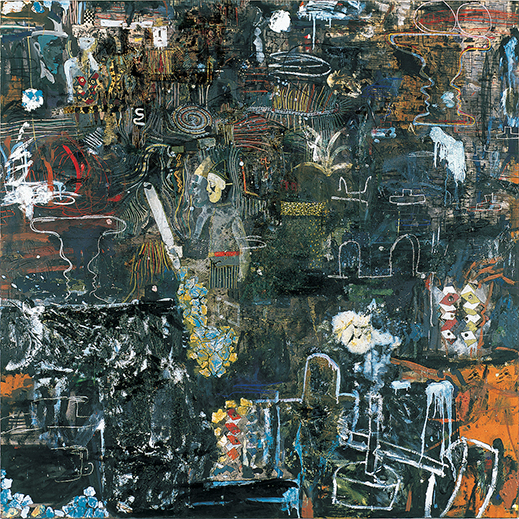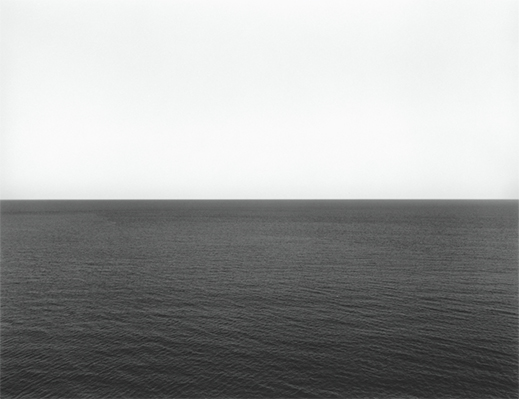 |
|
Here and There introduces art, artists, galleries, museums, and other cultural facilities around Japan that non-Japanese readers and first-time visitors may find of particular interest.
|
|
 |
|
|
 |
 |
Sagacho Exhibit Space: Giving an Incubator of Japanese Contemporary Art Its Due
Alan Gleason |
 |
The Shokuryo Building, a steel-reinforced concrete structure built after the Kanto Earthquake of 1923 destroyed its wooden predecessor. Photo by Masayuki Hayashi |
In November 2002 I made my way to an old brick-and-concrete building in the Saga district on the east bank of Tokyo's Sumida River, and joined the throngs filling the central courtyard for a last chance to see this legendary place. Soon it would be torn down and replaced by a condo. Built in 1927, the Shokuryo Building was a former rice storehouse that, between 1983 and 2000, had been the epicenter of contemporary art in Japan. Now, for its last hurrah, the former tenants who had made and displayed art here were going all-out in a farewell exhibition poignantly titled Emotional Site. It was the first and last time I got to see the Sagacho Exhibit Space, which had nurtured so many young artists who are now big names.
|
 |
|
|
|
Katsuya Komagata, Untitled, 1985, MTM Collection. Photo by Masayuki Hayashi
|
Sagacho Exhibit Space was the brainchild of Kazuko Koike, who had worked in advertising for Parco, among other firms, and with her colleagues at Kitchen Inc., an all-women studio that planned and produced design-related projects. Koike's exposure to the budding contemporary art scene of the 1960s and 1970s, and to the trend in places like New York of converting industrial spaces into galleries, had whetted her interest in developing a similar venue in Tokyo. The old-guard galleries in the tony Ginza district were notorious for their conservatism, and Koike felt that young artists needed a place where they could exhibit works without fear or favor. When Kitchen's Atsuko Koyanagi discovered the Shokuryo Building in 1983, it was still occupied by the offices of rice dealers, but on the third floor was an empty auditorium, eerily church-like, with high ceilings and cathedral windows. Koike fell in love with the room, a lease was signed, and Sagacho Exhibit Space was born.
Touted as Japan's first "alternative space" -- neither art museum nor commercial gallery -- Sagacho rapidly attracted the attention of artists and gallery owners, who began snatching up offices in the same building as soon as they were vacated. Some of Tokyo's best-known contemporary art galleries, among them Tomio Koyama, Taro Nasu, and ShugoArts, got their start here. Likewise, many of Japan's most acclaimed contemporary artists got their first chance to exhibit in public at Sagacho. Yasumasa Morimura, Hiroshi Sugimoto, Minoru Nomata, Shinro Ohtake, Katsuya Komagata . . . the list is long.
 |
|
Shinro Ohtake, Genova V, 1986, private collection, © Shinro Ohtake. |
Twenty years have passed since the Sagacho Exhibit Space closed its doors. Koike moved her operations to Sagacho Archives, a small gallery at 3331 Arts Chiyoda, a converted school in downtown Tokyo that in many ways has picked up the alternative-space torch from Sagacho. (See the May 2018 Here and There for a review of Minoru Nomata's exhibition there, which also describes how Nomata came to hold his first solo show at Sagacho Exhibit Space in 1986.) The other Shokuryo Building tenants dispersed across Tokyo, with some growing successful enough to open attractive new venues in Roppongi and other high-rent parts of town.
The first gallery of the exhibition, featuring a wooden scale model and a large photo of Sagacho Exhibit Space by Kozo Miyoshi. Photo by Hiroshi Yoshino (Hiroshi Yoshino Architects) |
But the legend of Sagacho lives on, and finally, after two decades in limbo, it is getting its props in a very rewarding show at the Museum of Modern Art, Gunma. Open until 13 December, Sagacho Exhibit Space 1983-2000: Fixed-Point Observation of Contemporary Art achieves two objectives: to chronicle the gallery's history, and to display, in one space, a sampling of the remarkable art it introduced. The first room at the Gunma show features rows of annotated monochrome shots of every one of the 106 exhibitions held at Sagacho in those 17 years. One wall is dominated by a huge photo of the converted auditorium, complemented by a wooden scale model of the room. Another gallery features an array of flyers, magazines, and other archival materials related to Sagacho.
Table display of leaflets printed by Sagacho Exhibit Space about each exhibition. Photo by Hiroshi Yoshino (Hiroshi Yoshino Architects) |
But the real treat awaits in the largest gallery, where a cross section of the art that graced Sagacho's walls fills the room. Some 40 works by 25 of the more than 400 artists who exhibited there have been selected for display in roughly chronological order. Moving through the gallery from piece to piece, it feels like one is wandering down a time tunnel that reconstructs the trajectory of contemporary art in Japan from the early eighties to the end of the century.
Installation view of Sagacho Exhibit Space 1983-2000, with Fumio Tachibana's collage work Umeboshi (1994) partially visible at right. |
Curator Katsutoshi Taniuchi explains that all the works chosen for this show were actually displayed at Sagacho and substantially retain their original form (a few have been touched up in the intervening years by the artists). Per the exhibition's subtitle, the idea is that they collectively constitute a "fixed-point" sequence of snapshots of Sagacho's presentations during the years of its existence.
|
Yasumasa Morimura, Daughter of Art History, Princess A, 1989, collection of the Sezon Museum of Modern Art.
|
|
Minoru Nomata, Still-14, 1986, private collection. |
Highlights include early works by the aforementioned artists, including Ohtake's sprawling expressionist paintings, Morimura's bold insertions of himself into classical art (often in drag), Nomata's byzantine architectural fantasies, and Sugimoto's meditative photographic seascapes. Some other standouts are Masao Okabe's wall-length pencil-on-cloth tour-de-force, Strike-Struck-Stroke at Sagacho (1986/2020); Rieko Hidaka's equally monumental, surprisingly faithful rendering of tree branches, Looking Up the Trees VII (1993); Yuki Onodera's evocative series of monochrome photos, Portrait of Second-Hand Clothes (1994-97); and Satoshi Hirose's Mar Rosso (Knot-hole) (1998), a vast blood-red Persian gabbeh carpet that occupies an entire room.
Installation view with Masao Okabe's Strike-Struck-Stroke at Sagacho (1986/2020) at left, and a partial rear view of Fumio Tachibana's Umeboshi (1994) at right. Photo by Hiroshi Yoshino (Hiroshi Yoshino Architects) |
Taniuchi was instrumental in bringing the Sagacho exhibition to the Gunma museum, which is located in the city of Takasaki about 100 kilometers northwest of Tokyo. The seeds for the show were sown as far back as 2010, when he curated a major exhibition of works by Minoru Nomata. When I spoke to Koike at Nomata's Sagacho Archives show in 2018, she mentioned her interest in finding a museum that would host a large-scale exhibition about Sagacho Exhibit Space. Though she didn't mention it by name, it turns out she was thinking about the museum in Gunma all along.
It's a fortuitous choice of venues. Designed in 1974 by the renowned architect Arata Isozaki (and described by some as his masterwork), the building sits in the midst of Gunma Forest Park, a beautiful expanse of lawns, trees and footpaths that preserves a bit of the old pastoral ambience of the northern Kanto area. While Takasaki is some distance from Tokyo, it takes less than an hour to get there on the Shinkansen bullet train, and this show is well worth the trip for anyone interested in taking a stroll through a veritable forest of contemporary Japanese art.
 |
|
Hiroshi Sugimoto, Caribbean Sea, Jamaica, 1980, private collection, © Hiroshi Sugimoto, courtesy of Gallery Koyanagi. |
All images courtesy of the Museum of Modern Art, Gunma, and Sagacho Archives. |
 |
| Sagacho Exhibit Space 1983-2000 |
| 12 September - 13 December 2020 |
| The Museum of Modern Art, Gunma |
Gunma Forest Park, 992-1 Watanuki-cho, Takasaki, Gunma
Phone: 027-346-5560
Hours: 9:30 a.m. to 5:00 p.m. (entry until 4:30 p.m.); closed Monday (or the next day if Monday is a national holiday)
Access: 25 minutes by bus (Gunma no Mori stop) from JR Takasaki Station, which is one hour by Shinkansen train from Tokyo Station
|
|
|
|
| |
 |
Alan Gleason
Alan Gleason is a translator, editor and writer based in Tokyo, where he has lived for over 30 years. Since 2006 he has edited artscape Japan and written the Here and There column, as well as translating the Picks reviews. He also edits and translates works on Japanese architecture, music, and theater. |
|
|
|
|
|
|
|
|
|
 |
|